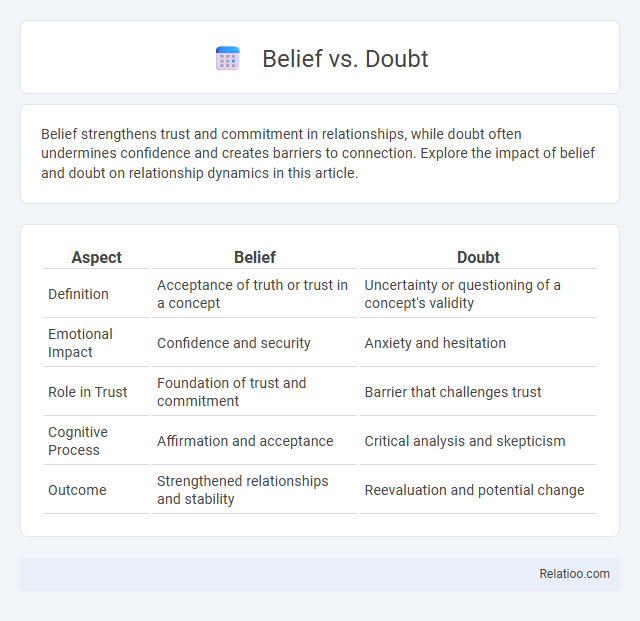Belief strengthens trust and commitment in relationships, while doubt often undermines confidence and creates barriers to connection. Explore the impact of belief and doubt on relationship dynamics in this article.
Table of Comparison
| Aspect | Belief | Doubt |
|---|---|---|
| Definition | Acceptance of truth or trust in a concept | Uncertainty or questioning of a concept's validity |
| Emotional Impact | Confidence and security | Anxiety and hesitation |
| Role in Trust | Foundation of trust and commitment | Barrier that challenges trust |
| Cognitive Process | Affirmation and acceptance | Critical analysis and skepticism |
| Outcome | Strengthened relationships and stability | Reevaluation and potential change |
Understanding Belief and Doubt
Understanding belief involves recognizing it as a mental acceptance or conviction in the truth of a statement, often without requiring empirical evidence. Doubt, contrastingly, represents a state of uncertainty or questioning that challenges the validity and reliability of a belief. The interplay between belief and doubt is critical for cognitive processes such as decision-making, learning, and critical thinking, as it drives individuals to evaluate information critically and seek evidence before forming conclusions.
The Psychology Behind Belief
The psychology behind belief reveals how your brain processes information and forms convictions that shape your worldview. Belief activates neural pathways tied to emotion and reasoning, reinforcing certainty even in the absence of empirical evidence. Understanding the cognitive mechanisms separating belief from doubt can help you critically evaluate ideas and make informed decisions.
What Fuels Doubt in the Human Mind
Uncertainty in human cognition is primarily fueled by a lack of concrete evidence, conflicting information, and emotional influences such as fear or anxiety. Neurological studies reveal that the prefrontal cortex plays a key role in processing doubt by evaluating risks and assessing probabilities. Cognitive biases, such as confirmation bias and ambiguity aversion, also intensify doubt, hindering clear decision-making and belief formation.
Belief and Doubt in Decision-Making
Belief influences decision-making by providing a foundation of confidence and guiding choices based on perceived truths or values. Doubt introduces hesitation and critical evaluation, allowing individuals to question assumptions and consider alternative possibilities. Balancing belief and doubt enhances decision quality by fostering both conviction and open-mindedness.
The Role of Culture in Shaping Beliefs
Culture profoundly influences your beliefs by shaping the values, norms, and narratives you internalize from an early age. These cultural frameworks act as lenses through which you interpret experiences, determining whether you accept ideas with conviction or approach them with skepticism. Understanding the cultural context provides insight into the dynamic interplay between belief and doubt within different societies.
How Doubt Leads to Critical Thinking
Doubt acts as a catalyst for critical thinking by encouraging you to question assumptions and evaluate evidence logically. Unlike blind belief, doubt fosters a mindset that seeks clarity and understanding through analysis and reasoning. This process helps refine ideas, improve decision-making, and promotes intellectual growth.
Balancing Belief and Doubt for Personal Growth
Balancing belief and doubt is essential for personal growth, as belief provides motivation and confidence to pursue goals while doubt encourages critical thinking and self-reflection. Embracing a healthy skepticism helps to challenge assumptions and refine one's understanding without succumbing to paralysis by indecision. Cultivating this equilibrium enhances emotional resilience and fosters continual learning and adaptation.
The Impact of Belief and Doubt on Relationships
Belief fosters trust and emotional security in relationships, creating a foundation for meaningful connection and cooperation. Doubt generates uncertainty and hesitation, often leading to communication breakdowns and emotional distance between partners. Understanding the delicate balance between belief and doubt is essential for nurturing resilient and healthy relationships.
Overcoming Paralyzing Doubt
Overcoming paralyzing doubt requires understanding the critical difference between belief and doubt, where belief fuels confidence and doubt can hinder progress by creating uncertainty. You can shift your mindset by replacing self-defeating thoughts with evidence-based affirmations to reinforce your trust in your abilities. Strengthening belief through consistent positive habits and seeking support can diminish the grip of doubt, enabling decisive actions toward your goals.
Embracing Healthy Skepticism
Embracing healthy skepticism allows you to balance belief and doubt effectively, fostering critical thinking and informed decision-making. While belief drives confidence and motivation, doubt encourages questioning and prevents blind acceptance, creating a dynamic interplay crucial for intellectual growth. Cultivating this mindset enhances your ability to analyze information objectively and develop well-founded conclusions.

Infographic: Belief vs Doubt
 relatioo.com
relatioo.com